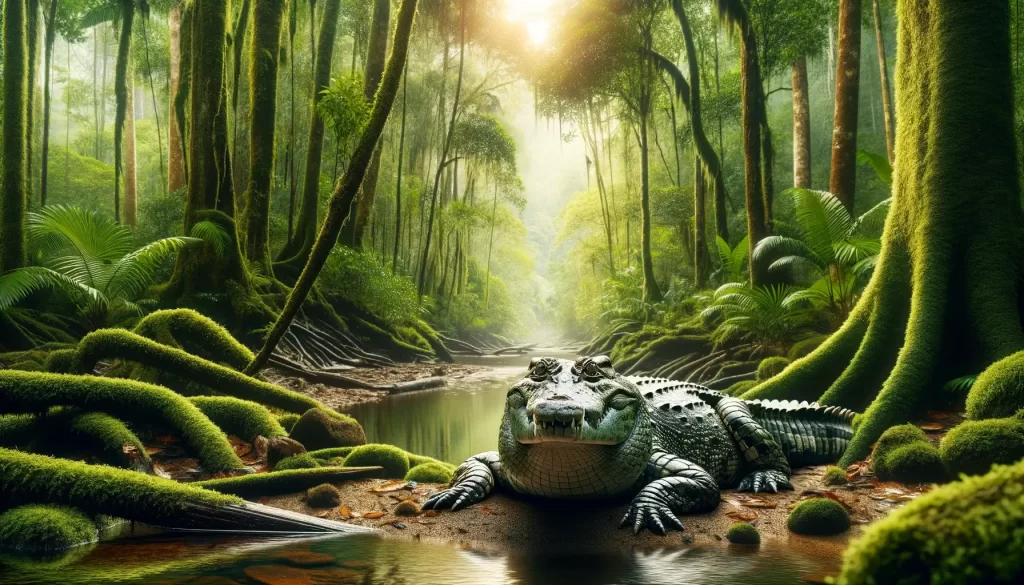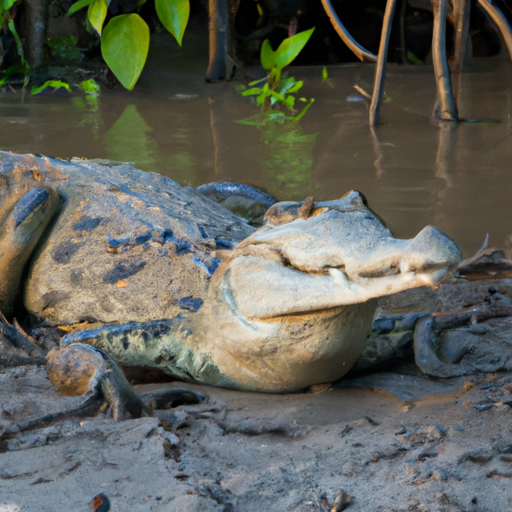
Crocodiles are fascinating creatures that have captured the curiosity of many. You may have wondered about their habitats and what environments they thrive in.
In this article, we will explore the question, “Do crocodiles live in rainforests?” Join us as we delve into the intriguing world of crocodiles and uncover the surprising answer to this query.
Introduction to Crocodiles
Crocodiles are fascinating creatures that have captured the curiosity of humans for centuries. These reptiles possess a majestic aura and are often associated with the wild and untamed.
In this article, we will explore the intriguing connection between crocodiles and rainforests. It might surprise you to learn that these ancient predators do indeed inhabit the lush, green canopies of rainforest ecosystems.
Let’s delve into the general information about crocodiles, the specific species that can be found in rainforests, and the unique adaptations that allow them to thrive in these vibrant habitats.
General Information about Crocodiles
Crocodiles belong to the order Crocodylia, which includes crocodiles, alligators, caimans, and gharials.
They are large, aquatic reptiles known for their long bodies, strong jaws with sharp teeth, and scaly skin.
With a history dating back over 200 million years, crocodiles are considered living fossils. There are currently 15 recognized species of crocodiles, each with its own distinctive characteristics and distribution patterns.
Crocodile Species
Different crocodile species can be found across various parts of the world, from the Americas to Africa, Asia, and Australia. Some notable species include the American Crocodile (Crocodylus acutus), Morelet’s Crocodile (Crocodylus moreletii), Orinoco Crocodile (Crocodylus intermedius), Nile Crocodile (Crocodylus niloticus), and Saltwater Crocodile (Crocodylus porosus). These species vary in size, behavior, and habitat preference.
Habitats of Crocodiles
Crocodiles are highly adaptable creatures that can thrive in a range of habitats, including rivers, lakes, estuaries, swamps, and even coastal areas. They are primarily found in tropical and subtropical regions of the world, where the climate and environmental conditions favor their survival. The abundance of water and suitable prey sources are crucial factors for crocodile habitats.
Rainforests as Habitats
Rainforests are lush, biodiverse havens that cover a significant portion of the Earth’s surface. They are characterized by dense vegetation, high rainfall, and a diverse array of plant and animal life. These magnificent ecosystems can be found in tropical regions across the globe, including the Amazon rainforest in South America, the Congo Basin in Africa, and the rainforests of Southeast Asia and Oceania.
Characteristics of Rainforests
Rainforests exhibit distinct characteristics that make them unique and invaluable. These ecosystems are distinguished by their towering trees, forming a dense canopy that blocks sunlight from reaching the forest floor. The canopy creates a shaded environment below, maintaining high humidity and creating a microclimate suitable for various organisms. Rainforests are also known for their rich soil, thriving under the continuous cycle of decomposition and nutrient recycling.
Biodiversity in Rainforests
One of the most remarkable features of rainforests is their unparalleled biodiversity. These ecosystems are home to an astonishing variety of plant and animal species, many of which are found nowhere else on Earth. Rainforests support countless insects, birds, reptiles, mammals, and amphibians, making them ecological hotspots. It is estimated that rainforests contain more than half of the Earth’s species, even though they only cover around 6% of the planet’s landmass.
Types of Rainforests
There are two primary types of rainforests: tropical rainforests and temperate rainforests. Tropical rainforests are found near the equator, where they experience consistent temperatures and high levels of annual rainfall. These rainforests boast an abundance of biodiversity and are renowned for their complex and intricate web of life. On the other hand, temperate rainforests occur in cooler regions, such as the Pacific Northwest of North America and parts of Southern Chile and New Zealand. These rainforests display unique characteristics and support different species adapted to cooler climates.
Crocodiles and Rainforests
Crocodiles and rainforests might not seem like an obvious pairing, but these formidable reptiles have found a way to coexist with the dense vegetation and diverse wildlife of these habitats. Let’s explore the connection between crocodiles and rainforests, including their distribution, native rainforests, and the adaptations that enable their survival in these dynamic environments.
Crocodile Distribution
Crocodiles have a widespread distribution, with various species inhabiting different regions across the globe. While not all crocodile species can be found in rainforests, several do dwell in these vibrant ecosystems. The specific species present in rainforests depend on the geographical location and the availability of suitable habitats.
Native Rainforests of Crocodile Species
Some crocodile species have established their territories in specific rainforest regions. For example, the American Crocodile is native to the Americas and can be found in the rainforests of Central and South America. Morelet’s Crocodile is also prevalent in the rainforest areas of Mexico, Belize, and Guatemala. The Orinoco Crocodile is native to the Orinoco River basin in Venezuela and Colombia, which includes rainforest habitats. The Nile Crocodile, famous for its presence in the African savannah, can also be found in the rainforests of Central and West Africa. Lastly, the Saltwater Crocodile, known for its ability to inhabit both saltwater and freshwater environments, can be found in the rainforests of Southeast Asia and northern Australia.

Adaptations of Crocodiles in Rainforests
Crocodiles have evolved numerous adaptations that allow them to thrive in rainforest habitats. These adaptations help them navigate through dense vegetation, find shelter, capture prey, and reproduce successfully. Some of the notable adaptations include camouflage and coloration, ambush predation techniques, an aquatic lifestyle, thermoregulation mechanisms, and unique nesting and reproduction strategies.
Camouflage and Coloration
Crocodiles possess remarkable camouflage and coloration that assists in their survival within rainforest habitats. Their scales often match the colors and patterns of the surrounding vegetation, making them nearly invisible when stationary in the water or partially submerged in mud or dense vegetation. This natural disguise helps them remain undetected by prey and potential predators, allowing them to ambush their unsuspecting prey effectively.
Ambush Predation
Crocodiles are renowned for their extraordinary patience and skill in hunting. In rainforest environments, they utilize their excellent camouflage to hide in wait for their prey near bodies of water or along forest edges. When an opportunity arises, they launch a lightning-fast attack, seizing their prey with their powerful jaws and dragging it into the water. This ambush predation strategy provides crocodiles with a reliable food source in rainforests.
Aquatic Lifestyle and Behavior
Crocodiles are well-adapted to an aquatic lifestyle, spending a significant portion of their time in water. This affinity for water is particularly beneficial in rainforests, where bodies of water are abundant. Crocodiles can swim swiftly, using their muscular tails to propel themselves through the water. Their streamlined bodies and webbed feet facilitate efficient movement, allowing them to navigate the intricate network of rainforest waterways with agility.
Thermoregulation
Rainforests are known for their warm and humid climate, and crocodiles have evolved mechanisms to regulate their body temperature in these conditions. They are ectothermic, meaning their internal body temperature fluctuates with the external environment. Crocodiles bask in the sun to increase their body temperature and retreat to the shade or water to cool down. The availability of diverse microclimates within rainforests allows crocodiles to find suitable areas to regulate their body temperature effectively.
Nesting and Reproduction in Rainforests
Rainforests serve as critical nesting grounds for crocodile species that inhabit these ecosystems. Female crocodiles construct nests, often in locations with abundant vegetation and suitable soil, where they lay their eggs. The warm and humid climate of rainforests offers ideal conditions for incubating the eggs. After a lengthy incubation period, the hatchlings emerge and make their way to water bodies, commencing their journey in the rainforest ecosystem.
Coexistence with Other Rainforest Species
Crocodiles play an essential role in rainforest ecosystems, interacting with a variety of species and contributing to the intricate balance of these habitats. Let’s explore the relationships crocodiles have with rainforest prey, predators, and their overall role as ecosystem engineers.
Rainforest Prey
Crocodiles have a diverse diet that consists of various rainforest prey species. They are opportunistic feeders and readily consume fish, amphibians, turtles, birds, and mammals that venture close to water bodies. Their powerful jaws and sharp teeth allow them to catch and consume a wide range of prey, making them vital components of the rainforest food web.
Interactions with Rainforest Predators
While crocodiles may be the apex predators of their habitats, they share their rainforest environments with other formidable predators. In rainforests, crocodiles may come into contact with large cats like jaguars, anacondas, or pythons. These encounters can occasionally result in conflicts over food or territories. However, crocodiles generally avoid confrontations with these predators and prefer to maintain a peaceful coexistence.
Ecosystem Role of Crocodiles
Crocodiles serve as ecosystem engineers in rainforests, making significant contributions to the overall health and functioning of these habitats. Their feeding behavior helps control prey populations, preventing overpopulation of certain species and maintaining ecological balance. Additionally, crocodile nests provide essential nutrients to the soil, promoting the growth of vegetation in their vicinity. These actions make crocodiles instrumental in shaping rainforest ecosystems.
Threats and Conservation
Despite their historical resilience, crocodiles face numerous threats that put their survival at risk. Human activities and environmental changes place significant pressures on these iconic creatures and their rainforest habitats. Let’s explore some of the key threats they face and the conservation efforts in place to protect them.
Habitat Loss and Fragmentation
Rainforest destruction, primarily driven by deforestation for logging, agriculture, and urban development, poses a severe threat to crocodile habitats. As rainforests shrink in size, crocodile populations become fragmented, making it difficult for individuals to find suitable territories and mate. Habitat loss also reduces the availability of prey, further impacting crocodile populations.
Hunting and Illegal Trade
Historically, crocodiles have been hunted for their valuable skin, which is used in the production of luxury goods such as handbags and shoes. While legal restrictions on hunting and regulated trade have been implemented in many countries, illegal hunting and trade still persist. This illicit activity poses a grave threat to crocodile populations, especially in regions with weak law enforcement.
Conservation Efforts
Recognizing the importance of preserving crocodile species and their unique habitats, conservation efforts have been implemented worldwide. These efforts include the establishment of protected areas, the enforcement of hunting and trade regulations, and public education and awareness programs. International collaborations through organizations like the International Union for Conservation of Nature (IUCN) aim to promote the conservation of crocodile species and work towards their long-term survival.
Final Thoughts
Crocodiles are captivating creatures that have successfully adapted to thrive in rainforest habitats.
Despite the challenges posed by habitat loss and human activities, these extraordinary reptiles continue to play important ecological roles in maintaining the delicate balance of rainforest ecosystems.
By understanding and appreciating the connections between crocodiles and rainforests, we can work towards their conservation and ensure that future generations can marvel at the wonders of these ancient creatures in their natural habitats.



